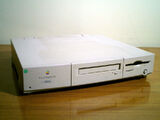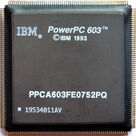No edit summary |
No edit summary |
||
| Line 6: | Line 6: | ||
[[PowerPC]]-based computers sold by Apple at the time of the release of the [[Pippin]] platform used a 4-digit number to distinguish various models, sometimes followed by a slash with the processor {{w|clock speed}}. |
[[PowerPC]]-based computers sold by Apple at the time of the release of the [[Pippin]] platform used a 4-digit number to distinguish various models, sometimes followed by a slash with the processor {{w|clock speed}}. |
||
| − | Pippin consoles were based on |
+ | Pippin consoles were based on an architecture similar to the [[w:c:apple:Power Macintosh 6100|Power Macintosh 6100]],<ref name="macgeek-image-archive">[http://www.macgeek.org/museum/pippin/photoalbum.html Bandai Pippin Image Archive] by Bryan G. Villados, ''The Mac Geek''. Accessed 2017-04-15.</ref> though with a 66MHz [[w:c:apple:PowerPC 603|PowerPC 603]] processor and a [[PCI]] bus (instead of a [[w:c:apple:PowerPC 601|601]] processor with [[w:c:apple:NuBus|NuBus]]), running a streamlined version of [[Mac OS|Macintosh operating system]] [[w:c:apple:Mac OS 7.5.2|7.5.2]]. This allowed hobbyists with access to [[Kinka ROM|developer ROMs]] to modify Pippins to run standard Mac software of the era.<ref name="hacking">[https://web.archive.org/web/20170817231339/http://www.vintagemacworld.com/pip1.html Hacking the Pippin], Vintage Mac World. 2007-10-22. Archived 2017-08-17</ref> The [[w:c:apple:Power Macintosh 6200|Power Macintosh 6200]] and [[w:c:apple:Power Macintosh 5200 LC|5200 LC]] were the only other computers from Apple to use the original PowerPC 603 processor like the Pippin (not the faster [[w:c:apple:PowerPC 603e|603e]] or [[w:c:apple:PowerPC 603ev|603ev]]).<ref name="lowendmac-603">[http://lowendmac.com/2014/cpus-powerpc-603-and-603e/ CPUs: PowerPC 603 and 603e] by Daniel Jansen, Low End Mac. 2014-06-24.</ref> |
==Evolution and discontinuation== |
==Evolution and discontinuation== |
||
Latest revision as of 23:53, 6 September 2020

A Power Macintosh 6100/66, used as a benchmark for early Pippin development.
Power Macintosh was a line of workstation-class computers developed and marketed by Apple Computer from March 1994 to August 2006. These were based on PowerPC RISC microprocessors for improved performance over the original 68k-based Macintosh line. Consumer-class computers from Apple with lower-end PowerPC processors were sold under the Macintosh Performa brand.
Power Macintosh and the Pippin[]

A 75MHz PowerPC 603 processor.
PowerPC-based computers sold by Apple at the time of the release of the Pippin platform used a 4-digit number to distinguish various models, sometimes followed by a slash with the processor clock speed.
Pippin consoles were based on an architecture similar to the Power Macintosh 6100,[1] though with a 66MHz PowerPC 603 processor and a PCI bus (instead of a 601 processor with NuBus), running a streamlined version of Macintosh operating system 7.5.2. This allowed hobbyists with access to developer ROMs to modify Pippins to run standard Mac software of the era.[2] The Power Macintosh 6200 and 5200 LC were the only other computers from Apple to use the original PowerPC 603 processor like the Pippin (not the faster 603e or 603ev).[3]
Evolution and discontinuation[]
Over the next twelve years, the Power Macintosh line evolved through a succession of enclosure designs, a rename to "Power Mac", five major generations of PowerPC chips, and a great deal of press coverage, design accolades, and controversy about performance claims. The Power Mac was discontinued in 2006, following Apple's transition to Intel processors.[4]
References[]
- ↑ Bandai Pippin Image Archive by Bryan G. Villados, The Mac Geek. Accessed 2017-04-15.
- ↑ Hacking the Pippin, Vintage Mac World. 2007-10-22. Archived 2017-08-17
- ↑ CPUs: PowerPC 603 and 603e by Daniel Jansen, Low End Mac. 2014-06-24.
- ↑ Four years later: Why did Apple drop PowerPC? by Brooke Crothers, CNET. 2009-06-15.
See also[]
External links[]
- Bandai Pippin Frequently Asked Questions at The Mac Geek
- Power Macintosh at the Apple Wiki
- Power Macintosh at the Macromedia Wiki
- Power Macintosh at Wikipedia
